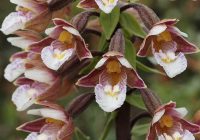Dr Phil Smith’s Wildlife Notes
June 2017
There could hardly be a greater contrast; Edinburgh had the wettest June ever, while desperately needed rain fell here on only eight days during the month. Though limited in quantity, it allowed some recovery of sand-dune vegetation and even stimulated a little Natterjack Toad activity, a few late spawn strings being found, though they didn’t survive long. The dune water-table continued to fall, partly due to a heat-wave from 17th to 21st, including the hottest June day nationally since 1976.
New discoveries were a feature of the month, one being a first for the Sefton Coast in the form of Monkeyflower (Mimulus moschatus) found by Patricia Lockwood on the dried-up floor of Wicks Lake, Formby Point. Although widely naturalised, especially in the uplands, this attractive North American plant had not been seen here before. A Birkdale slack produced another outstanding find – the extremely rare white form of Early Marsh-orchid, which I have seen only twice before. As I was walking back from Devil’s Hole on 25th the sun came out and two sooty brown butterflies flew up in front of me. With mounting excitement, I realised they were not the expected Meadow Browns but Ringlets, an insect that was first recorded on the dunes last summer at Ainsdale Sand Dunes National Nature Reserve. I retuned the following day and counted 28 Ringlets, mostly freshly emerged, in a 100m stretch of tall grassland between the end of Range Lane and Asparagus Cottage. This is about 5km south of the Ainsdale site, quite a journey for such a slow-flying butterfly.
As usual, I was involved in guiding groups that come from far and near to enjoy the natural wonders of the Sefton Coast. They included a party from Wharfedale in Yorkshire who spent three days here in mid-month. I showed them the amazing botanical riches of Birkdale Green Beach where, aside from the obvious attractions of rarities like Baltic Rush and Tubular Water-dropwort, the golden expanses of Kidney Vetch created a visual impact that is hard to beat. Their final visit was to the spectacular Devil’s Hole blowout, a treat for anyone interested in wild flowers. Coincidentally, my article on this exceptional place appeared in the June issue of British Wildlife. Members of the Royal Photographic Society found lots of White Satin moths at Ainsdale Sandhills, though they were down in numbers compared with recent years, probably due to the drought. There were hardly any Bee Orchids, for the same reason. Sefton Landscape Partnership organised a similar walk at Ainsdale with about 30 enthusiastic participants, a highlight being Field Gentian in flower, normally not seen until August. Despite the dry conditions, there were fine displays of brick-red Early Marsh-orchids and Marsh Helleborines, the latter species also appearing at the Devil’s Hole in great abundance towards the end of the month.
It is easy to forget that these lovely flowers are largely absent from the general countryside and are Red Data listed as Near Threatened in England. The key to their future is habitat protection and effective management, as at Altcar Training Camp where the Conservation Advisory Group inspected a large area of formerly overgrown fixed-dune that has been mowed in two successive years. The improvement has been dramatic, with a return to diverse vegetation, including large numbers of wild orchids. Other good finds were Flat-sedge, Variegated Horsetail, Pink Water-speedwell, Lesser Centaury and Brackish Water-crowfoot. Quaking-grass was so abundant as to give a pinkish haze to the sward. Best of all was a large stand of Shoreweed in one of the scrapes. I haven’t seen this on the coast for many years.
The dry conditions may have been a factor in the apparent shortage of butterflies until the last week of the month when there was a hatch of Small Skippers, Meadow Browns and the afore-mentioned Ringlets. Dragonflies seemed less affected and I was delighted to find a Black-tailed Skimmer at Birkdale on 9th. This species also enjoyed the heat-wave, with at least three, including a pair, at Sands Lake on 20th and 21st, together with five Four-spotted Chasers, an Emperor and the usual damselflies. Pinfold Pond on Ainsdale NNR also had a good selection of dragonflies, the first Southern Hawker of the summer being a welcome sight on 18th, though five dogs in the water was inappropriate.
Finally, I returned to Haskayne Cutting Nature Reserve a few miles inland to complete the orchid count begun in late May. This time the target was the Early Marsh-orchid which, despite its name, always flowers later than its relatives in this region. I counted 133 flowering spikes, all being the Nationally Scarce and endemic coastal form coccinea. This encouraging increase on 54 plants the previous year is attributable to late summer mowing of the habitat by the Lancashire Wildlife Trust.




